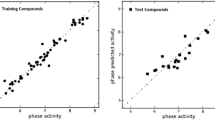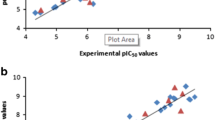Abstract
PLK-2 is a serine/threonine protein kinase and plays a crucial role in cell cycle regulation; due to its pivotal function, this enzyme is approved as cancer drug target. We used BI-2536 a PLK-1/PLK-2 inhibitor to build a pharmacophore model and applied in the virtual screening of ZINC database to retrieve new molecules that bind the active site of PLK-2 environment with a high fit value. The molecules that do not fit the enzyme active site environment were subjected to conformation enrichment by generation of conformations in the active site environment by molecular docking, and the molecules with new scaffold that did not pass into the active site from molecular docking were subjected to molecular pruning to delete bulky substituents that prevent the molecules from binding. Molecular docking was used to find the binding pose of the selected molecules into active site of PLK-2; all screened-in hit molecules make favorable non-bonding interactions with PLK-2 active site similar to the reference inhibitor. Molecular dynamics simulations, the binding free energy calculations of the complexes, and the stability of hydrogen bonding interactions further revealed the usefulness of these screened compounds as suitable hit molecules for inhibition of PLK-2.









Similar content being viewed by others
References
Anand P, Kunnumakara AB, Sundaram C, Harikumar KB, Tharakan ST, Lai OS, Sung B, Aggarwal BB (2008) Cancer is a preventable disease that requires major lifestyle changes. Pharm Res 25(9):2097–2116
Islami F, Goding Sauer A, Miller KD, Siegel RL, Fedewa SA, Jacobs EJ, McCullough ML, Patel AV, Ma J, Soerjomataram I, Flanders WD (2018) Proportion and number of cancer cases and deaths attributable to potentially modifiable risk factors in the United States. CA Cancer J Clin 68(1):31–54
Wang H, Naghavi M, Allen C, Barber RM, Bhutta ZA, Carter A, Casey DC, Charlson FJ, Chen AZ, Coates MM, Coggeshall M (2016) Global, regional, and national life expectancy, all-cause mortality, and cause-specific mortality for 249 causes of death, 1980–2015: a systematic analysis for the Global Burden of Disease Study 2015. Lancet 388(10053):1459–1544
Sawyers C (2004) Targeted cancer therapy. Nature 432(7015):294
Noble ME, Endicott JA, Johnson LN (2004) Protein kinase inhibitors: insights into drug design from structure. Science 303(5665):1800–1805
Zhang J, Adrián FJ, Jahnke W, Cowan-Jacob SW, Li AG, Iacob RE, Sim T, Powers J, Dierks C, Sun F, Guo GR (2010) Targeting Bcr–Abl by combining allosteric with ATP-binding-site inhibitors. Nature 463(7280):501
Manning G, Whyte DB, Martinez R, Hunter T, Sudarsanam S (2002) The protein kinase complement of the human genome. Science 298(5600):1912–1934
Barnum KJ, O’Connell MJ (2014) Cell cycle regulation by checkpoints. Cell Cycle Control. Humana Press, New York, NY, pp 29–40
Malumbres M, Barbacid M (2009) Cell cycle, CDKs and cancer: a changing paradigm. Nat Rev Cancer 9(3):153
Barr FA, Silljé HH, Nigg EA (2004) Polo-like kinases and the orchestration of cell division. Nat Rev Mol Cell Biol 5(6):429
Holtrich U, Wolf G, Bräuninger A, Karn T, Böhme B, Rübsamen-Waigmann H, Strebhardt K (1994) Induction and down-regulation of PLK, a human serine/threonine kinase expressed in proliferating cells and tumors. Proc Natl Acad Sci U S A 91(5):1736–1740
Steegmaier M, Hoffmann M, Baum A, Lénárt P, Petronczki M, Krššák M, Gürtler U, Garin-Chesa P, Lieb S, Quant J, Grauert M (2007) BI 2536, a potent and selective inhibitor of polo-like kinase 1, inhibits tumor growth in vivo. Curr Biol 17(4):316–322
Lénárt P, Petronczki M, Steegmaier M, Di Fiore B, Lipp JJ, Hoffmann M, Rettig WJ, Kraut N, Peters JM (2007) The small-molecule inhibitor BI 2536 reveals novel insights into mitotic roles of polo-like kinase 1. Curr Biol 17(4):304–315
Zhan MM, Yang Y, Luo J, Zhang XX, Xiao X, Li S, Cheng K, Xie Z, Tu Z, Liao C (2018) Design, synthesis, and biological evaluation of novel highly selective polo-like kinase 2 inhibitors based on the tetrahydropteridin chemical scaffold. Eur J Med Chem 143:724–731
Cizmecioglu O, Krause A, Bahtz R, Ehret L, Malek N, Hoffmann I (2012) Plk2 regulates centriole duplication through phosphorylation-mediated degradation of Fbxw7 (human Cdc4). J Cell Sci 125(4):981–992
Hu ZB, Liao XH, Xu ZY, Yang X, Dong C, Jin AM, Lu H (2016) PLK 2 phosphorylates and inhibits enriched TA p73 in human osteosarcoma cells. Cancer Med 5(1):74–87
Inglis KJ, Chereau D, Brigham EF, Chiou SS, Schöbel S, Frigon NL, Yu M, Caccavello RJ, Nelson S, Motter R, Wright S (2009) Polo-like kinase 2 (PLK2) phosphorylates α-synuclein at serine 129 in central nervous system. J Biol Chem 284(5):2598–2602
Aubele DL, Hom RK, Adler M, Galemmo Jr RA, Bowers S, Truong AP, Pan H, Beroza P, Neitz RJ, Yao N, Lin M (2013) Selective and brain-permeable polo-like kinase-2 (Plk-2) inhibitors that reduce α-synuclein phosphorylation in rat brain. ChemMedChem 8(8):1295–1313
Reddy MR, Akula B, Jatiani S, Vasquez-Del Carpio R, Billa VK, Mallireddigari MR, Cosenza SC, Subbaiah DV, Bharathi EV, Pallela VR, Ramkumar P (2016) Discovery of 2-(1H-indol-5-ylamino)-6-(2, 4-difluorophenylsulfonyl)-8-methylpyrido [2, 3-d] pyrimidin-7 (8H)-one (7ao) as a potent selective inhibitor of Polo like kinase 2 (PLK2). Bioorg Med Chem 24(4):521–544
Lounnas V, Ritschel T, Kelder J, McGuire R, Bywater RP, Foloppe N (2013) Current progress in structure-based rational drug design marks a new mindset in drug discovery. Comput Struct Biotechnol J 5(6):e201302011
Walters WP, Stahl MT, Murcko MA (1998) Virtual screening—an overview. Drug Discov Today 3(4):160–178
Merz Jr KM, Ringe D, Reynolds CH (eds) (2010) Drug design: structure-and ligand-based approaches. Cambridge University Press, Cambridge
Cherkasov A, Muratov EN, Fourches D, Varnek A, Baskin II, Cronin M, Dearden J, Gramatica P, Martin YC, Todeschini R, Consonni V (2014) QSAR modeling: where have you been? Where are you going to? J Med Chem 57(12):4977–5010
Irwin JJ (2008) Community benchmarks for virtual screening. J Comput Aided Mol Des 22(3-4):193–199
Rella M, Rushworth CA, Guy JL, Turner AJ, Langer T, Jackson RM (2006) Structure-based pharmacophore design and virtual screening for novel angiotensin converting enzyme 2 inhibitors. J Chem Inf Model 46(2):708–716
Wermuth CG, Ganellin CR, Lindberg P, Mitscher LA (1998) Glossary of terms used in medicinal chemistry (IUPAC Recommendations 1998). Pure Appl Chem 70(5):1129–1143
Kandakatla N, Ramakrishnan G. (2014). Ligand based pharmacophore modeling and virtual screening studies to design novel HDAC2 inhibitors. Adv Bioinforma 2014.
Yang SY (2010) Pharmacophore modeling and applications in drug discovery: challenges and recent advances. Drug Discov Today 15(11-12):444–450
Lavecchia A (2015) Machine-learning approaches in drug discovery: methods and applications. Drug Discov Today 20(3):318–331
Šali A, Blundell TL (1993) Comparative protein modelling by satisfaction of spatial restraints. J Mol Biol 234(3):779–815
Sunseri J, Koes DR (2016) Pharmit: interactive exploration of chemical space. Nucleic Acids Res 44(W1):W442–W448
Irwin JJ, Sterling T, Mysinger MM, Bolstad ES, Coleman RG (2012) ZINC: a free tool to discover chemistry for biology. J Chem Inf Model 52(7):1757–1768
Rao SN, Head MS, Kulkarni A, LaLonde JM (2007) Validation studies of the site-directed docking program LibDock. J Chem Inf Model 47(6):2159–2171
Kabsch W (1976) A solution for the best rotation to relate two sets of vectors. Acta Crystallogr Sect A 32(5):922–923
Bathula SR, Akondi SM, Mainkar PS, Chandrasekhar S (2015) Pruning of biomolecules and natural products (PBNP): an innovative paradigm in drug discovery. Org Biomol Chem Royal Soc Chem 13(23):6432–6448
Brooks BR, Bruccoleri RE, Olafson BD, States DJ, Swaminathan SA, Karplus M (1983) CHARMM: a program for macromolecular energy, minimization, and dynamics calculations. J Comput Chem 4(2):187–217
Wu G, Robertson DH, Brooks III CL, Vieth M (2003) Detailed analysis of grid-based molecular docking: a case study of CDOCKER—A CHARMm-based MD docking algorithm. J Comput Chem 24(13):1549–1562
Muegge I (2006) PMF scoring revisited. J Med Chem 49(20):5895–5902
Hess B, Kutzner C, Van Der Spoel D, Lindahl E (2008) GROMACS 4: algorithms for highly efficient, load-balanced, and scalable molecular simulation. J Chem Theory Comput 4(3):435–447
Van Der Spoel D, Lindahl E, Hess B, Groenhof G, Mark AE, Berendsen HJ (2005) GROMACS: fast, flexible, and free. J Comput Chem 26(16):1701–1718
Hornak V, Abel R, Okur A, Strockbine B, Roitberg A, Simmerling C (2006) Comparison of multiple Amber force fields and development of improved protein backbone parameters. Proteins 65(3):712–725
da Silva AW, Vranken WF (2012) ACPYPE-Antechamber python parser interface. BMC Res Notes 5(1):367
Wang J, Wang W, Kollman PA, Case DA (2006) Automatic atom type and bond type perception in molecular mechanical calculations. Mol Graph Model 25(2):247–260
Berendsen HJ, Postma JP, van Gunsteren WF, Hermans J (1981) Interaction models for water in relation to protein hydration. Intermolecular forces. Springer, Dordrecht, pp 331–342
Darden T, York D, Pedersen L (1993) Particle mesh Ewald: An N log (N) method for Ewald sums in large systems. J Chem Phys 98(12):10089–10092
Essmann U, Perera L, Berkowitz ML, Darden T, Lee H, Pedersen LG (1995) A smooth particle mesh Ewald method. J Chem Phys 103(19):8577–8593
Hess B, Bekker H, Berendsen HJ, Fraaije JG (1997) LINCS: a linear constraint solver for molecular simulations. J Comput Chem 18(12):1463–1472
Bussi G, Donadio D, Parrinello M (2007) Canonical sampling through velocity rescaling. J Chem Phys 126(1):014101
Parrinello M, Rahman A (1981) Polymorphic transitions in single crystals: a new molecular dynamics method. J Appl Phys 52(12):7182–7190
Bakan A, Meireles LM, Bahar I (2011) ProDy: protein dynamics inferred from theory and experiments. Bioinformatics 27(11):1575–1577
Humphrey W, Dalke A, Schulten K (1996) VMD: visual molecular dynamics. J Mol Graph 14(1):33–38
Homeyer N, Gohlke H (2012) Free energy calculations by the molecular mechanics Poisson− Boltzmann surface area method. Mol Inform 31(2):114–122
Kumari R, Kumar R, Open Source Drug Discovery Consortium, Lynn A (2014) g_mmpbsa– A GROMACS tool for high-throughput MM–PBSA calculations. J Chem Inf Model 54(7):1951–1962
Kothe M, Kohls D, Low S, Coli R, Rennie GR, Feru F, Kuhn C, Ding YH (2007) Selectivity-determining residues in Plk1. Chem Biol Drug Des 70(6):540–546
Reymond JL, Awale M (2012) Exploring chemical space for drug discovery using the chemical universe database. ACS Chem Neurosci 3(9):649–657
Wolber G, Langer T (2005) LigandScout: 3-D pharmacophores derived from protein-bound ligands and their use as virtual screening filters. J Chem Inf Model 45(1):160–169
Wieder M, Garon A, Perricone U, Boresch S, Seidel T, Almerico AM, Langer T (2017) Common hits approach: combining pharmacophore modeling and molecular dynamics simulations. J Chem Inf Model 57(2):365–385
Xing L, Klug-Mcleod J, Rai B, Lunney EA (2015) Kinase hinge binding scaffolds and their hydrogen bond patterns. Bioorg Med Chem 23(19):6520–6527
Archer S, Glick SD, Bidlack JM (1996) Cyclazocine revisited. Neurochem Res 21(11):1369–1373
Archer S, Seyed-Mozaffari A, Jiang Q, Bidlack JM (1994) 14. alpha., 14'. beta.-[Dithiobis [(2-oxo-2, 1-ethanediyl) imino]] bis (7, 8-dihydromorphinone) and 14. alpha., 14'. beta.-[Dithiobis [(2-oxo-2, 1-ethanediyl) imino]] bis-7, 8-dihydro-N-(cyclopropyl-methyl) normorphinone: Chemistry and Opioid Binding Properties. J Med Chem 37(11):1578–1585
Araki M, Kamiya N, Sato M, Nakatsui M, Hirokawa T, Okuno Y (2016) The effect of conformational flexibility on binding free energy estimation between kinases and their inhibitors. J Chem Inf Model 56(12):2445–2456
Acknowledgments
The authors thank CMSD, University of Hyderabad, for providing computational facilities. MA thanks Ministry of Higher Education & Scientific Research - Republic of Yemen.
Author information
Authors and Affiliations
Corresponding author
Ethics declarations
Conflict of interest
The authors declare that they have no conflict of interest.
Ethical approval
This chapter does not contain any studies with human participants or animals performed by any of the authors.
Additional information
Publisher’s note
Springer Nature remains neutral with regard to jurisdictional claims in published maps and institutional affiliations.
Rights and permissions
About this article
Cite this article
Abdullah, M., Guruprasad, L. Computational basis for the design of PLK-2 inhibitors. Struct Chem 31, 275–292 (2020). https://doi.org/10.1007/s11224-019-01394-x
Received:
Accepted:
Published:
Issue Date:
DOI: https://doi.org/10.1007/s11224-019-01394-x




